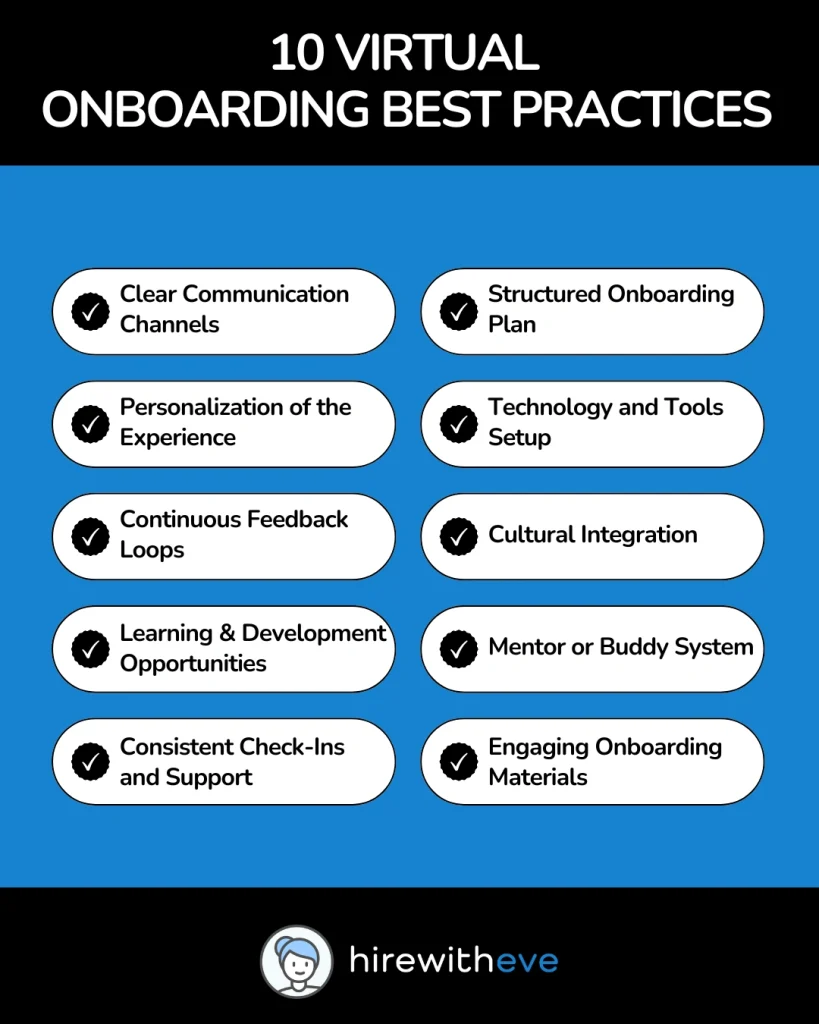10 Virtual Onboarding Best Practices You Need to Know

The shift to remote work has made virtual onboarding a critical component of modern HR practices. As talent acquisition specialists and HR managers adapt to this change, ensuring a seamless onboarding experience for new hires is more important than ever.
This blog will guide you through the top virtual onboarding best practices that will help you build a strong foundation for your remote employees, ensuring they are set up for success from day one.
Let’s read the blog and find the ten essential practices to make your Virtual Onboarding process more effective.
What is Virtual Onboarding?
Virtual Onboarding is the process of integrating new employees into a company remotely, ensuring they have the tools, knowledge, and support they need to succeed in their roles. Unlike traditional onboarding, which typically involves face-to-face meetings and in-person training, Virtual Onboarding takes place entirely online. It utilizes digital communication platforms, learning management systems, and virtual collaboration tools to replicate the onboarding experience in a remote environment.
The goal of virtual onboarding is to create a seamless transition for new hires, helping them feel connected to their team, familiar with the company’s culture, and equipped to perform their job functions effectively, all without ever setting foot in a physical office.
What are the 10 Virtual Onboarding best practices?

Clear Communication Channels
One of the primary challenges in virtual onboarding is the lack of face-to-face communication. It’s crucial to establish clear communication channels from the start. Tools like Slack, Microsoft Teams, or Zoom can help maintain regular contact and allow new hires to easily ask questions and seek clarification. Encourage team members to stay accessible and responsive to foster a sense of support and inclusion.
Clear communication not only helps with logistical matters but also establishes trust and a sense of belonging, which are key for retaining new employees after the virtual onboarding process.
Structured Onboarding Plan
A successful virtual onboarding experience begins with a well-structured plan. Create a timeline that outlines the first 30, 60, and 90 days of onboarding, clearly defining goals, expectations, and key milestones. This plan should include an introduction to the company culture, job-specific training, and opportunities for feedback.
Providing a roadmap helps new hires stay focused, making the transition smoother and more predictable. This structured approach is essential in a virtual setting, where employees may feel disconnected or overwhelmed during the early days of employment.
Personalization of the Experience
Every employee is unique, and virtual onboarding should reflect that. Personalize the onboarding process to cater to the individual’s role, learning style, and personality. Personalized welcome messages, tailored training sessions, and one-on-one meetings with managers can make new hires feel more connected to their teams and the company.
Incorporating these personalized touches ensures that your virtual onboarding process remains engaging and relevant, enhancing the overall employee experience.
Technology and Tools Setup
Ensuring that your new hires have the right technology and tools in place before their first day is essential for virtual onboarding success. HR teams should coordinate with IT to set up accounts, provide access to necessary software, and ensure that hardware (such as laptops or monitors) is delivered on time.
Consider creating an IT checklist that is shared with new employees so they can easily navigate their tech setup and avoid unnecessary frustrations.
Continuous Feedback Loops
Feedback is essential to the virtual onboarding process. Schedule regular check-ins during the first few weeks to gather feedback on how the new hire is adapting and whether they have all the resources they need. This feedback will help you identify any gaps in the onboarding process and address them in real-time.
An open feedback loop allows HR teams to continually improve their virtual onboarding practices, creating a more streamlined and supportive experience for future hires.
Cultural Integration
Company culture can be hard to convey in a virtual setting, yet it is a crucial aspect of any virtual onboarding process. Create opportunities for new hires to engage with their team members through virtual coffee chats, team-building activities, and all-hands meetings.
By fostering cultural integration, you can help new employees feel more connected to their team and the organization, even if they’re working remotely.
Learning and Development Opportunities
A strong virtual onboarding program should include learning and development opportunities to help new hires grow in their roles. Offer access to online training programs, webinars, and resources that allow them to expand their knowledge and skills. Encourage self-paced learning to accommodate different work styles and preferences.
Learning opportunities not only help with immediate job responsibilities but also set the tone for continuous professional development throughout the employee’s tenure.
Mentor or Buddy System
Assigning a mentor or buddy to new employees during their virtual onboarding can ease the transition process. This person can serve as a go-to for questions and guides navigating company systems and culture.
Having a mentor or buddy gives new hires a personal connection within the company, making them feel supported and valued during their initial weeks and beyond.
Consistent Check-Ins and Support
Frequent communication with HR and management is key to a successful virtual onboarding process. Schedule regular check-ins to assess how well the new hire is adjusting and whether they need additional support or resources. This ensures that any issues are addressed quickly and prevents the employee from feeling isolated in their new role.
Consistent support throughout the onboarding process makes employees feel more secure and confident as they integrate into their new positions.
Engaging Onboarding Materials
Traditional onboarding manuals may not work well in a virtual environment. Instead, create engaging, interactive virtual onboarding materials that include videos, quizzes, and infographics. This type of content is easier to digest and helps reinforce important concepts, making the learning experience more enjoyable.
Interactive materials also allow new employees to engage with the content at their own pace, increasing retention and understanding.
Conclusion
The Virtual Onboarding process is a critical step in ensuring the success of remote employees. By following these ten best practices, HR managers and talent acquisition specialists can create a seamless and effective onboarding experience that supports new hires and sets them up for long-term success.
At HirewithEve.ai, we understand the importance of streamlined onboarding processes in the remote work era. Our platform offers features that enhance virtual onboarding, which includes skills-based hiring, remote hiring support, and real-time feedback systems. With HirewithEve.ai, you can ensure that your new employees have smooth hiring support and an engaging virtual onboarding experience, all while staying connected with the team and company culture.
Make the most of your virtual onboarding with the right tools, and set your employees on the path to success from day one.





